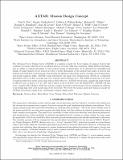AXTAR: Mission design concept
Author(s)
Ray, Paul S.; Chakrabarty, Deepto; Wilson-Hodge, Colleen A.; Philips, Bernard F.; Wood, Kent S.; Wolff, Michael T.; Gwon, Chul S.; Strohmayer, Tod E.; Baysinger, Michael; Briggs, Michael S.; Capizzo, Peter; Fabisinski, Leo; Hopkins, Randall C.; Hornsby, Linda S.; Johnson, Les; Maples, C. Dauphne; Miernik, Janie H.; Thomas, Dan; de Geronimo, Gianluigi; Remillard, Ronald A; Levine, Alan M; ... Show more Show less
DownloadRay-2010-AXTAR Mission design concept.pdf (2.524Mb)
PUBLISHER_POLICY
Publisher Policy
Article is made available in accordance with the publisher's policy and may be subject to US copyright law. Please refer to the publisher's site for terms of use.
Terms of use
Metadata
Show full item recordAbstract
The Advanced X-ray Timing Array (AXTAR) is a mission concept for X-ray timing of compact objects that combines very large collecting area, broadband spectral coverage, high time resolution, highly flexible scheduling, and an ability to respond promptly to time-critical targets of opportunity. It is optimized for submillisecond timing of bright Galactic X-ray sources in order to study phenomena at the natural time scales of neutron star surfaces and black hole event horizons, thus probing the physics of ultradense matter, strongly curved spacetimes, and intense magnetic fields. AXTAR's main instrument, the Large Area Timing Array (LATA) is a collimated instrument with 2-50 keV coverage and over 3 square meters effective area. The LATA is made up of an array of supermodules that house 2-mm thick silicon pixel detectors. AXTAR will provide a significant improvement in effective area (a factor of 7 at 4 keV and a factor of 36 at 30 keV) over the RXTE PCA. AXTAR will also carry a sensitive Sky Monitor (SM) that acts as a trigger for pointed observations of X-ray transients in addition to providing high duty cycle monitoring of the X-ray sky. We review the science goals and technical concept for AXTAR and present results from a preliminary mission design study.
Date issued
2010-07Department
Massachusetts Institute of Technology. Department of Physics; MIT Kavli Institute for Astrophysics and Space ResearchJournal
Proceedings of SPIE--the International Society for Optical Engineering; v. 7732
Publisher
SPIE
Citation
Ray, Paul S. et al. “AXTAR: mission design concept.” Space Telescopes and Instrumentation 2010: Ultraviolet to Gamma Ray. Ed. Monique Arnaud, Stephen S. Murray, & Tadayuki Takahashi. San Diego, California, USA: SPIE, 2010. 773248-19. © 2010 COPYRIGHT SPIE
Version: Final published version
ISSN
0277-786X